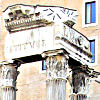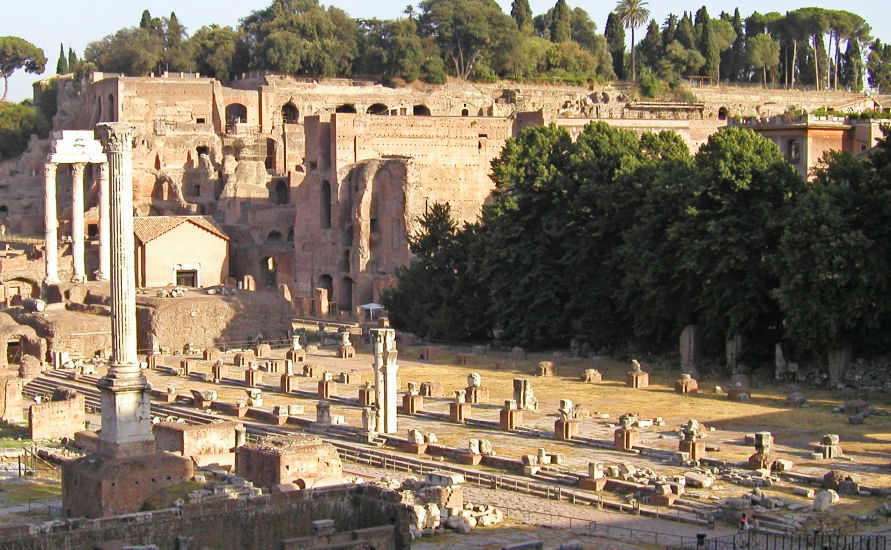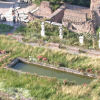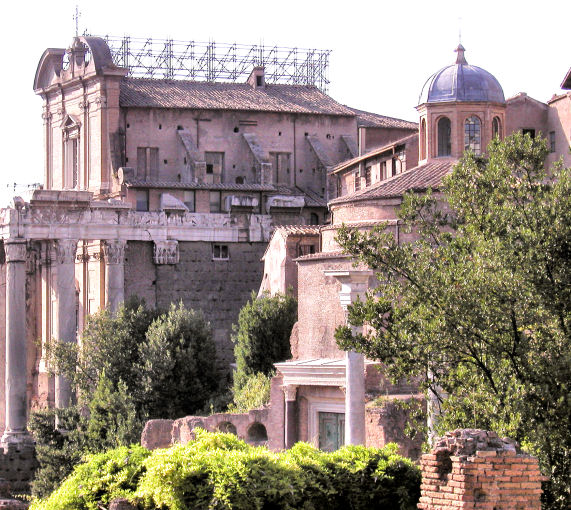This is the default narration at loading ...
Contents here



Roman Forum
...or Foro Romano in todays Italian and Forum Romanum as it was called by the Romans in the Latin language. This area was the political, commercial and religious center of ancient Rome.
Cradled between the three hills of Palatine, Capitol and Esquiline, the Romans established their imperial center after having dried up the surrounding marshlands.
All the way from the 6th century BC, Forum Romanum kept its status as a center of the State and the capital for almost ten centuries, unsurpassed by any other city center in history.
Today only scattered ruins remain, but with a little imagination these ancient relics can still reach out and speak of former greatness.


Via Sacra
Forum Romanum was built, expanded and rebuilt innumerous times over the ten centuries so what we see today is a mixture of many different political eras.
The Forum was crossed lengthwise by the broad boulevard of Via Sacra, being the oldest section of the Forum.
The photo shows one end of Via Sacra at Capitol.
The Arch of Septimius Severus, built in 203 AD, dominates the foreground and the Palatine Hill -well populated with trees- rise up towards the background.
In the front, a little left of center, is the tall column of Phocas, an Eastern Roman Emperor. Dedicated on August 1, 608 AD, it was the last addition made to the Forum.


Arch of Septimius Severus
The marble Arch of Septimius Severus stands at the foot of Capitol Hill and the begining of the Forum's Via Sacra.
The arch was dedicated 203 AD as a triumph to commemorate the emperor's victories in the Parthian Wars (today's Iran).
Statues of the emperor and his two sons, Caracalla and Geta, in a four-horse chariot adorned the top of the arch, but they have later been removed.


Temple of Saturn
Still at the foot of Capitol Hill and west of Via Sacra stands the Temple of Saturn, the Roman mythological God of Agriculture. All that remains are eight columns of the front portico and part of the base.
The original temple built around 510-500 BC was completely reconstructed 42 BC by Roman senator and consul Lucius Munatius Plancus.
Completely destroyed in a fire, the third construction was inaugurated 283 AD and these are the ruins we see today. The inscription on the top frieze reads The Senate and People of Rome restored what the fire consumed.
The temple was used to store the Republic's gold and silver reserves and housed the official scale for weighing metals.


Temple of Vespasian
Also at the foot of Capitol Hill and west of Via Sacra stands the Temple of Vespasian and Titus, two Roman emperors of the Flavian Dynasty.
Construction of the temple, originally in honor of his father, Emperor Vespasian (69-79 AD), was begun by Emperor Titus (79-81) and completed under his successor, Roman Emperor Domitian (81-96). All three formed the Flavian Dynasty and the temple was constructed in order to eternalize the fame and glory of the Flavian family after Vespasian and Titus were deified.
All that remains today is the core of the podium and three Corinthian columns (photo) at the south-east corner.


Basilica Julia
This large rectangular construction is located along the southern side of Forum's west end, neighboring the Temple of Saturn.
The Roman basilica was a large roofed hall for doing business and handling of legal matters and could be found in any respectably sized Roman city.
Julius Ceasar commenced construction in 46 BC but after his assasination on 15 March 44 BC the basilica was completed by his adopted son and subsequent Roman Emperor Augustus. He named it in honor of his assasinated father.
All that remains is the foundation, floors, the full length marble stairs leading into the building, and a single, lonely rebuilt column from the original building.


Temple of Castor and Pollux
These three Corinthian columns stand out prominently in the ruins of the Forum.
They are the remains of the Temple of Castor and Pollux, aka. "Temple of Dioscuri", Castor and Pollux being the "twins" (dioscuri) of Gemini, the twin sons of Zeus (Jupiter) and Leda.
Erected as far back as 484 BC. to commemorate the infant republic's victory over the last king of Rome and the Latins, his allies, the temple is located next to the Basilica and the Arch of Augustus.
The three columns are however part of a later reconstruction in the 1st or 2nd century AD.


Temple of Vesta
Vesta is the mythological virgin Roman goddess of the hearth, home, and family. Her presence was symbolized with a(n eternal) sacred fire in a temple or hearth. Vesta's temples were always round.
The Temple of Vesta was constructed at the very dawn of Forum Romanum. It burned down several times and the current ruins is a poor reconstruction from the 1930s during the dictatorship of Benito Mussolini.
The Vestal Virgins maintained the fire in a hearth in the temple. It was believed that if the fire extinguished then the goddess had removed her protection of the city.
Allowing the fire to die was punished with scourging.


House of Vestals
This was a three-story house at the foot of Palantine Hill in which the Vestal Virgins lived. The elongated building had 50 rooms surrounding a large, central atrium with two pools.
Enrolled at the age of 6-10, Vestals took a vow of chastity for 30 years, violation of which was punished with burial alive. The first decade they were students, then they actively served the next decade and finally spent the last 10 years as teachers.
The Vestals were sacrosanct -injuring a Vestal meant automatic capital punishment.
Because they were incorruptible, pure and with high integrity, their word would be trusted and they were entrusted with safe keeping of wills and important state documents such as treaties.


Temple of Caesar
The Temple of Caesar (left on photo around a grey triangular roof) closed off the south-eastern end of the square. Today, only few ruins of the podium structure remain.
Construction of the temple commenced in 42 BC -two years after the assassination of Caesar- by Octavian in memory of his famous uncle. He chose the site where Caesar met his faith.
Right of the temple on the photo, a person in a red T-shirt is walking on the remains of the foundation of the Arch of Augustus, which was dedicated in 29 BC.
The white ruins of Temple of Vesta are prominent behind the platform ruins of the Arch of Augustus.


Temple of Antoninus and Faustina
This is one of the best preserved structures at the Forum, mainly because it was converted into church.
It was dedicated in 141 AD by Antoninus Pius to his wife, and, after his own death in 161 AD, re-dedicated to them both by Marcus Aurelius, his successor.


Temple of Romulus
Not to be confused with the founder of Rome, this temple (right on photo) was dedicated in 309 AD by Western Emperor Maxentius to his recently deceased 14 year old son, Valerius Romulus.
The building is a bit unusual but also refreshing, being a circular building flanked by two rectangular structures.


Temple of Romulus
The original bronze doors at the entrance to the Temple of Romulus are still extant.
It is no longer possible to enter the temple through these doors though. Instead the circular structure has been incorporated into the church behind it and access can be gained that way.


Arch of Titus
Located prominently on the Velian Hill, the highest point on Via Sacra, stands the elegant Arch of Titus.
It was erected 81-82 AD. by Emperor Domitian to commemorate his older brother Titus' victories, especially the Siege of Jerusalem in 70 AD.


Arch of Titus
Emperor Titus was deified for his great achievements.
The inscription on top of his arch reads SENATVS POPVLVSQVE·ROMANVS DIVO·TITO·DIVI·VESPASIANI·F(ILIO) VESPASIANO·AVGVSTO, which means "Roman Senate and People to the divine Titus Vespasianus Augustus, son of the divine Vespasian"


Circus Maximus
Circus Maximus, on the other side of the Palantine Hill (right on photo) from the Forum, is among the oldest constructions in Rome having been built prior to 330 BC.
The circus was a long, narrow racecourse divided down the middle by the so-called "Spine". In one end were the starting stalls from where the races began and along both sides were the seats with a capacity of some 250,000 people in Circus Maximus.
The horse races were widely popular with up to 240 racedays per year.


Tired?
The burning sun takes its toll on the weary tourists ...
More albums from Italy, Rome and Pompeii can be found under "Other galleries" above